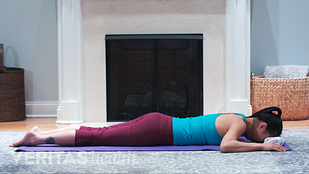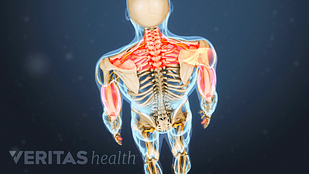These tips can help to prevent and treat text neck.
Watch:文本颈部治疗视频
Treating text neck, also called tech neck, typically involves a two-pronged approach:
- Exercises and stretches to increase the neck’s strength and flexibility
- Improved postural habits when using smartphones and other mobile devices
The strategies on this page for treating and/or preventing neck pain while using smartphones also apply to tablets, e-readers, and other handheld devices.
Adjustments to Prevent Text Neck Pain
Raise your phone to eye-level when texting or reading.
- Raise the phone。Move the phone (and other devices) up closer to eye level so the head does not have to be tilted forward.
- Take frequent breaks。花点time away from the phone—or any type of head-forward posture. If needed, use an alarm or app to set automatic reminders to take breaks from handheld devices.
- Stand up straight。Good posture, with the chin tucked in and shoulders pulled back, keeps the body aligned in a neutral position.
- Arch and stretch。Arch the neck and upper back backward periodically to ease muscle pain.
- Exercise regularly.A strong, flexible back and neck are more able to handle extra stress. Some research indicates that teenagers who are active in low-impact team sports or endurance sports are less likely to have neck pain.1
In general, finding ways to keep the neck and body more active, rather than hunched over a mobile device, is best for the spine. For example, try scheduling just a few times per day to check text messages and emails, rather than responding multiple times per hour.
In This Article:
- How Does Text Neck Cause Pain?
- Text Neck Symptoms and Diagnosis
- Text Neck Treatment and Prevention
- 文本颈部治疗视频
- Neck Strains and Sprains Video
Exercises and Stretches to Reduce Neck Pain
With text neck and other conditions related to forward head posture, muscle imbalances usually develop as follows:
- The deep cervical flexor muscles at the front of the neck become elongated while the muscles connected to the head at the back of the neck become shortened
- The upper back muscles become elongated while the chest muscles become shortened
SeeForward Head Posture’s Effect on Neck Muscles
Any exercise program to help alleviate text neck pain and reduce forward head posture typically involves addressing and reversing these muscle imbalances to restore a more naturally-aligned posture. Some common options include:
- Physical therapy program.A physical therapist or other health care professional can design a stretching and strengthening program for the patient’s specific needs. This program is typically performed at a clinic, at least initially, to ensure that the stretches and exercises are performed in an effective and safe manner. Depending on each case, several training sessions may be needed prior to advancing to an independent, patient-specific home exercise program.
- Home exercises.Many exercises and stretches can be done at home to improve the neck’s strength and flexibility, as well as to reduce forward head posture. Though each case is unique, achieving long-term pain relief from text neck usually takes a commitment to regularly performing exercises and stretches in the home setting.
Some evidence also suggests that performing exercises and stretches in a school setting can help improve posture. One study looked at 130 teenagers with forward head and protracted shoulder posture. Half of the students were enrolled in a physical education class that also included exercises and stretches designed to correct postural muscle imbalances. After 16 weeks, the students in the class with targeted exercises had more improvements in both neck and shoulder posture compared to the other students.2
SeeDaily Exercises and Stretches to Prevent Neck Pain
As an overall guide, regularly engaging in exercise that teaches posture and body awareness is an excellent way to counteract the tendency of developing neck pain from poor posture. Examples of such exercise programs include yoga, Pilates, Alexander Technique, and others.3
SeeNeck Exercises for Neck Pain
When to See a Doctor for Neck Pain
If neck pain keeps returning or is accompanied by a severe headache, fever, nausea, unintended weight loss, dizziness, pain or tingling that radiates down into the arm or hand, or other troubling symptoms, it is important to seek medical attention. Any of these symptoms with neck pain could indicate a serious underlying medical condition that needs to be accurately diagnosed by a doctor in order to get the correct treatment.
References
- 1.Guddal MH, Stensland SØ, Småstuen MC, Johnsen MB, Zwart JA, Storheim K. Physical Activity Level and Sport Participation in Relation to Musculoskeletal Pain in a Population-Based Study of Adolescents: The Young-HUNT Study. Orthop J Sports Med. 2017;5(1):2325967116685543.
- 2.Ruivo RM, Pezarat-Correia P, Carita AI. Effects of a resistance and stretching training program on forward head and protracted shoulder posture in adolescents. J Manipulative Physiol Ther. 2017; 40:1-10.
- 3.Becker JJ, Copeland SL, Botterbusch EL, Cohen RG. Preliminary evidence for feasibility, efficacy, and mechanisms of Alexander technique group classes for chronic neck pain. Complement Ther Med. 2018;39:80-86.








